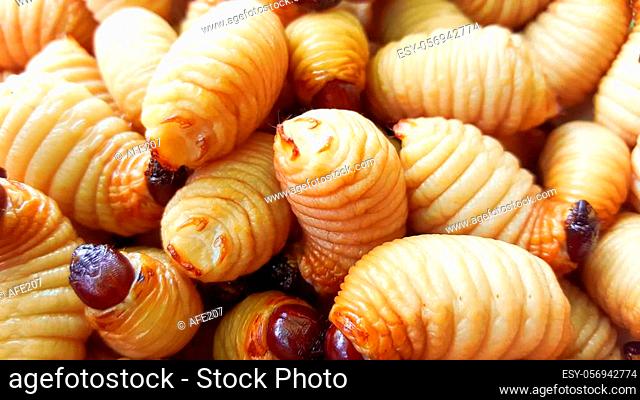Known as Butod or grub, this wriggling creature is a delicacy in Sabah and is rich in protein. It can be eaten raw and is often fried or roasted on a spit.
Sago grubs, Rhynchophorus ferrugineus, are edible insect larvae that feed on the starchy pith of palm trees. They are a source of protein, which is essential for human survival.
Overview of Sago Grubs as a Food Source
Sago grubs are a staple of the diet in many countries in Southeast Asia. They are often fried and served with vegetables, and they also are roasted on a spit at special occasions.
They have a creamy, meaty texture when raw and are reminiscent of bacon when cooked. They are a highly nutrient-dense food, with protein and fats being the main components of their nutritional profile.
It contains a high amount of vitamin E and is rich in several minerals, including zinc and magnesium. This makes it a valuable source of nutrients and could help contribute to food security in sago-consuming communities.
Culinary Uses and Traditional Dishes Featuring Sago Grubs
In many Southeast Asian countries, sago grubs are considered delicacies. They are creamy tasting when raw and have a similar taste to bacon when cooked.
In Papua New Guinea, sago grubs can be roasted on a spit. They are also a popular ingredient in traditional dishes such as sago satay.
Sago grubs are the larvae of a beetle that lives inside the pith of palm trees. They are very large and full of protein and nutrients.
Availability and Market Trends of Sago Grubs Consumption
Throughout Southeast Asia and in parts of Papua New Guinea, Sago Grubs are highly regarded as a delicacy. They are cooked in a variety of ways, including raw, steamed wrapped in sago palm leaves, and roasted on a skewer.
These grubs are a good source of protein, fat, and iron. They also contain high dietary fiber, which may contribute to digestion.
The sago grub oil, which contains a high proportion of unsaturated fatty acids (MUFA+PUFA), was liquid even at a low storage temperature (4 degC). Unlike palm oil, which does not have detectable amounts of vitamin E, the sago grub oil was rich in d-tocopherol and had significantly higher b-tocopherol concentrations than a comparable study from Costa Rican palms. Additionally, lipid nutritional indicators such as o-6/o-3 and IA were within the ranges recommended for human health.
Health Benefits and Concerns
Sago grubs are the larvae of the red palm weevil (Rhynchophorus ferrugineus)–a species of snout beetle that excavates holes in palm tree trunks, weakening and killing the host plant. It is also a pest and a major concern for the sago palm industry worldwide.
In terms of nutrition, sago grubs contain all the essential amino acids. They also have high levels of fat, fatty acid, and vitamin E content, as well as a number of minerals.
These insects are also a rich source of iron, which is particularly important for people who consume low-iron diets. They also provide a range of vitamins and minerals that are not often found in other foods. In addition, they are free of toxic pesticides and heavy metals like cadmium and lead.
Sustainability Issues
Korowai communities along the eastern coastline of Papua use Rhynchophorus bilineatus, the sago palm beetle as an edible insect. The beetles are found throughout sago palm forests, and their larvae (sago grubs) can be collected from rotting palm trunks.
The sago grub is a high-protein source for the local population, and it has been widely consumed as a food. It is also a rich source of fats, amino acids, vitamins, and minerals such as calcium, zinc and magnesium.

